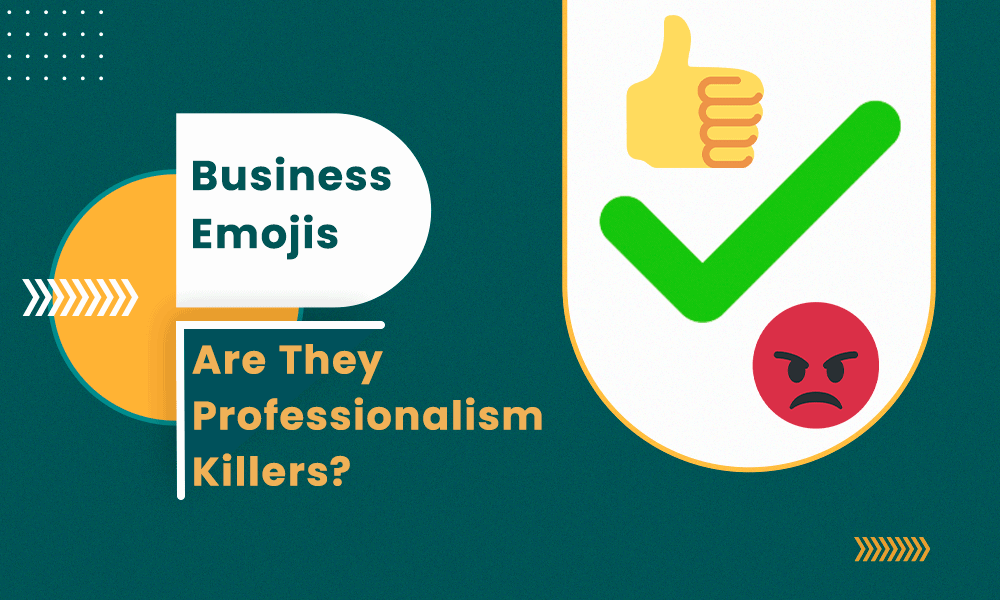Incorporating emojis in official business correspondence, be that an email or social media post, may seem risky, but there’s no need to shy away from emojis entirely.
Some research even suggests that using emojis in a message makes it seem more positive than omitting the emoji.
If this is true, which kinds of emojis are fine for in-office correspondence as well as emails to customers or leads? Oh, and which ones should you never, ever use for these purposes?
We’ll answer those questions, so let’s begin!
Table of Contents
5 Business-Safe Emojis to Use Without Sacrificing Professionalism
Does the smiley emoji cut the mark? Checks? Let’s take a deep dive and find out the emojis you can add to business communications without affecting professionalism.
1. Checkmark

Is the checkmark the most distinct emoji on your phone? No, and we’re not trying to pretend it is.
When you want to indicate to your boss that you’re getting your to-do list taken care of or when you’re sending an email to customers that includes a checklist, the checklist emoji works well.
It’s moderately playful, semi-colorful, and livens up your communications more than bullet points or a text checkmark.
Read also: Emoji Marketing: New Marketing Trend — Make Your Business Memorable
2. Smiley Emoji
It’s hard to be insulted by the presence of a smiley emoji. He’s just so happy and unassuming.
As we talked about in the intro, the inclusion of a smiley emoji will make a message seem more pleasant, which can come in handy when corresponding with leads.
Just don’t use this emoji too much, as then it can become weird and unprofessional.
Read also: 10 Funny Customer Success Memes That Every CSM Could Relate To
3. Thumbs Up

When your boss assigns you something to do, the thumbs up is a foolproof emoji to send in response. The OK hand, while used less often, also shouldn’t cause any in-office conniptions.
If you are going to use these emoji hands, the safest bet is to use the default yellow skin tone. This Simpsons-bright yellow is an unnatural color that won’t seem exclusionary.
You can also use these hand emojis in customer correspondence, such as social media posts, or even in an email subject line.
Read also: 12 Emojis You Thought You Knew and Their Actual Meaning
4. Handshake

Are you on the verge of onboarding a new client or closing a deal with a lead? The handshake emoji is another safe one to use in an office context.
As you did with the other hand emojis, stick to the default skin color, which is bright yellow.
5. Office Emojis

Any office emoji, from a pen to a laptop, a paper clip, a copier, as well as all the files and reports emojis are fair game in an office setting. Use this when needed — after all, everyone knows what a paper clip looks like and so they don’t need to see the emoji version.

5 Emojis to Avoid When Sending Business Correspondence
Now that you have a collection of office-friendly, professional emojis to send, we want to look at the opposite end of the coin.
The following emojis are unprofessional and should never ever be sent out to customers or your boss!
1. Thumbs Down

The thumbs-down emoji is fine if your friend is recommending a dinner joint and you don’t want to go. However, once you use this emoji in a work context, it just falls apart. The thumbs-down emoji feels just a little too defiant and even a touch threatening.
If you have a problem with an assignment you received, you’re better off taking it up with your boss rather than sending a passive-aggressive emoji like the thumbs down.
Read also: 10 Advertising Emojis To 10X Your Conversion Rates
2. Angry Face

Listen, work makes all of us angry sometimes. That’s just how it is.
However, part of being a professional is handling bad situations with poise and aplomb. If a customer ticks you off or suddenly backs out of the deal, you can’t send them the angry emoji.
You also can’t bombard your boss with this emoji if you get passed over for a promotion. That’s just wildly, ridiculously inappropriate.
3. Heart Emoji

In a different vein, it’s a good idea to stay away from the heart emoji.
Your leads are still unsure if they’re ready to commit to your company’s products and services. Coming on too strong with the heart emoji is a great way to lose a lead.
You also shouldn’t ever send a heart emoji in a business setting. It comes across as too flirty and romantic, neither of which you should be expressing in the workplace.
Read also: Customer Service Emojis – Add a Dash of Personalization
4. Poop Emoji

The poop emoji might be humorous, and if you want to save it for correspondence with your friends, that’s a-okay.
It has no place in an office setting, though, even though the poop emoji has variations such as sad poop, happy poop, and angry poop. Just skip them all.
We guarantee that your customers also probably won’t appreciate seeing this emoji in your social media posts or in an email (unless relevant :-))
Read also: Should You Use Emojis in Email Subject Lines?
5. Anything Incendiary

For as many wholehearted emojis as are out there, there are just as many that are incendiary, violent, and profane.
Skip the middle finger emoji, the censored profanity emoji, any violent weaponry (knife, gun, etc.), and any religious imagery.
Read also: Emoji with Symbols – Dress Up Your Marketing Messages
Conclusion
Emojis can be suitable for business communication, but only when used selectively. You want to be especially choosy about the emojis you use when corresponding with your boss as well as your leads and customers.
If in doubt, it’s better to skip the emojis altogether. We hope this guide helps you navigate your way around sending emojis to your colleagues and customers!

